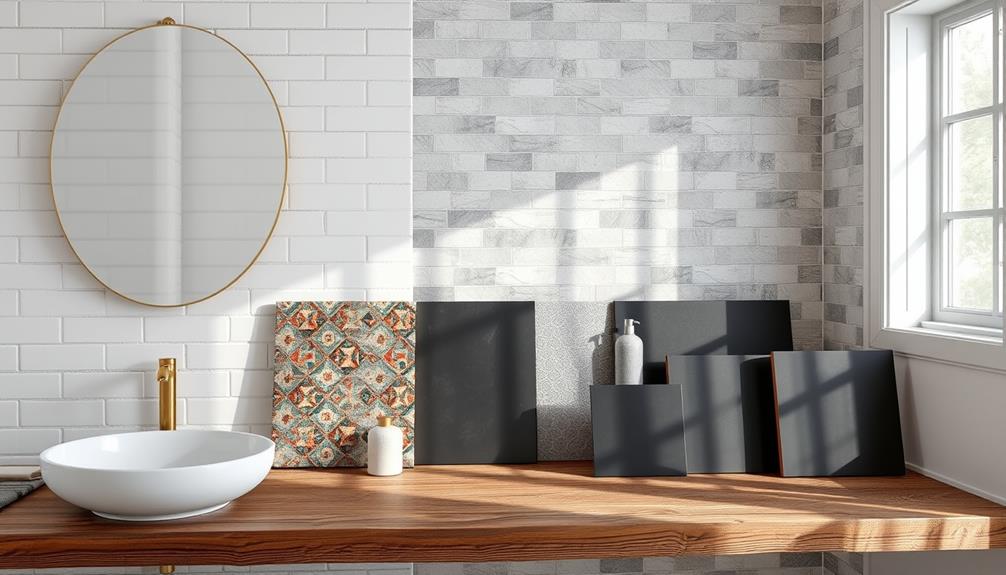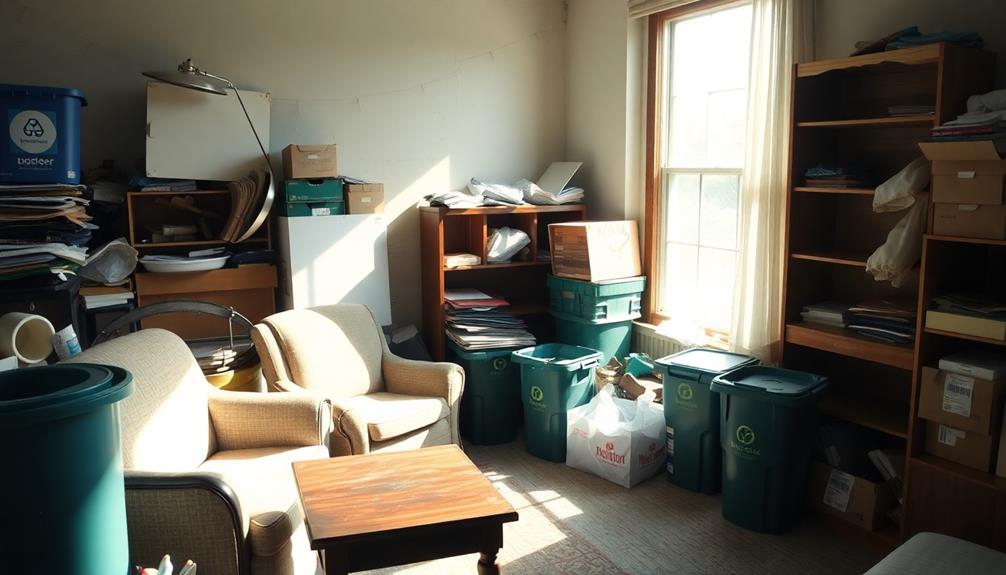When renovating your bathroom, selecting the right tiles involves considering several important factors. Take into account the size of the tiles; larger ones can create a more spacious feeling, while smaller tiles can add intricate details. Ensure that the tiles have slip resistance and moisture resistance for safety purposes. Choose a color palette that complements the space without overwhelming it, and mix different textures to add visual appeal. Remember that floor and wall tiles serve different functions, so choose them accordingly. It is also recommended to sample tiles and plan your budget carefully to avoid any unexpected costs. Having a good understanding of these factors will help make your project run more smoothly, so explore additional tips to elevate your bathroom makeover.
Key Takeaways
- Consider tile size: larger tiles reduce grout lines and create a spacious feel, while smaller tiles add detail and texture.
- Ensure slip resistance to prioritize safety in wet areas, focusing on moisture-resistant and stain-resistant tiles.
- Choose a cohesive color palette of 2-4 colors to enhance aesthetics without overwhelming the space.
- Assess material options: ceramic and porcelain are durable and easy to maintain, while natural stone offers elegance but requires sealing.
- Budget for tiles and installation, accounting for costs per square foot and allowing for a 10-15% increase for breakage.
Key Considerations for Tile Selection
When you're choosing tiles for your bathroom remodel, it's crucial to focus on several key factors that affect both aesthetics and functionality.
Start by considering the tile size; larger tiles can make a small space feel more expansive, while smaller tiles add detail and texture. Opt for slip-resistant floor tiles to enhance safety, especially in wet areas, and make sure they're resistant to staining and moisture. Incorporating natural materials, such as stone, can also align your bathroom with current Modern Farmhouse Decor Trends while adding a touch of elegance.
Light colors can create an illusion of spaciousness in your bathroom, making it appear larger than it is, while darker tiles offer a more intimate atmosphere.
Think about the different types of tiles, such as natural stone, ceramic, or porcelain, as each has unique characteristics and maintenance requirements. Smoother tiles are generally easier to clean, while textured options may require more upkeep.
Don't forget grout color and thickness, as they can greatly impact the overall look of your space. Choosing the right grout not only enhances your bathroom design but also contributes to the durability of your tiles.
Choosing the Right Design and Color
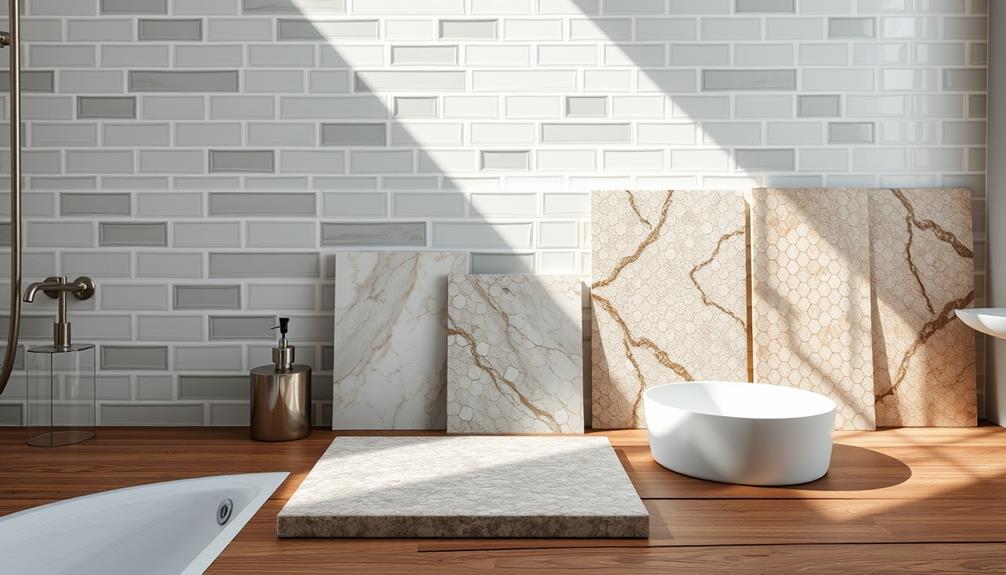
In designing your bathroom, the right tile colors and patterns can greatly influence the overall feel of the space. Start by choosing a color palette of 2-4 colors to maintain cohesion and avoid overwhelming the area. Light colors can create an illusion of spaciousness, while darker hues provide intimacy, especially in smaller bathrooms. Your color choice is essential to setting the room's atmosphere.
Additionally, consider how different brewing methods can affect the ambiance of your space, as a well-designed area can enhance your coffee experience at home, especially when enjoying a cup of coffee brewed with care.
Incorporate different textures within your selected palette to add dimension and visual interest. This enhances the overall aesthetic without clashing. For example, glossy tiles paired with matte finishes can create a striking look.
When selecting tile designs, make sure they complement your existing home decor. Minimalist styles favoring neutral tones work well in modern settings.
Additionally, consider utilizing contrasting grout colors. Dark grout can effectively hide stains, which is practical for busy bathrooms, while light grout can accentuate subtle design features, making your tile patterns pop.
Understanding Tile Sizes and Materials
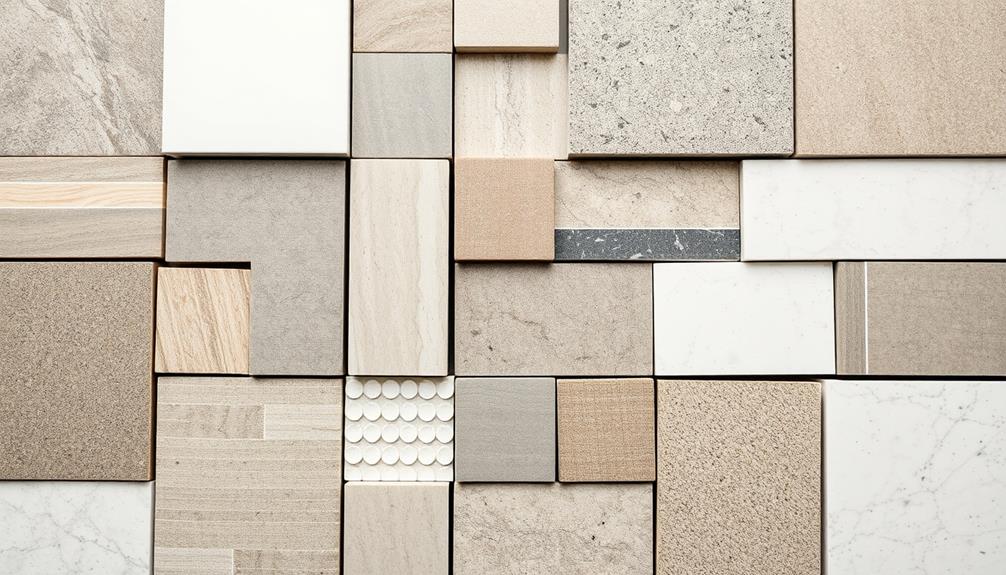
Choosing the right tile size and material is essential for a successful bathroom remodel. When considering tile sizes, you'll find options ranging from small formats like 300x300mm to larger ones such as 300x600mm.
Larger tiles can create a more spacious feel by reducing the number of grout lines, which can also make cleaning easier. Additionally, incorporating energy-efficient appliances into your bathroom design can contribute to overall sustainability in your home.
For materials, ceramic tiles are a popular choice due to their affordability and moisture resistance, making them ideal for damp areas like bathrooms. If you're looking for something more durable, porcelain tiles are denser and less porous than ceramic, providing enhanced durability and stain resistance, which is vital in high-moisture environments.
Natural stone tiles offer unique aesthetics and can elevate your bathroom's look, but they require regular sealing and maintenance to protect against staining and moisture damage.
On a budget? Vinyl tiles are an excellent option; they're completely waterproof and easy to clean, providing great value without sacrificing style.
Ultimately, understanding these tile sizes and materials will help you make informed decisions that enhance both the functionality and aesthetics of your bathroom remodel.
Differences Between Floor and Wall Tiles

Understanding the differences between floor and wall tiles is vital for any bathroom remodel. Floor tiles are typically thicker and more durable, designed to withstand foot traffic and provide slip resistance, which is essential for safety in wet areas.
You'll want to choose floor tiles that have a textured surface to enhance grip and prevent slipping. Additionally, considering the overall captivating narratives of your bathroom design can help you select tiles that not only serve a functional purpose but also create a cohesive aesthetic.
On the other hand, wall tiles can be lighter and thinner, allowing for versatile designs and easier installation. While they don't need to focus on slip resistance, it's important to guarantee they're securely adhered to avoid damage from moisture.
Wall tiles often feature smoother finishes, lending to their aesthetic appeal.
When it comes to grout, the type you select is equally important. Floor tile grout generally needs to be more robust and stain-resistant due to exposure to moisture and dirt.
In contrast, wall tile grout can be chosen for visual design, as durability is less of a concern.
Installation Tips and Cost Overview
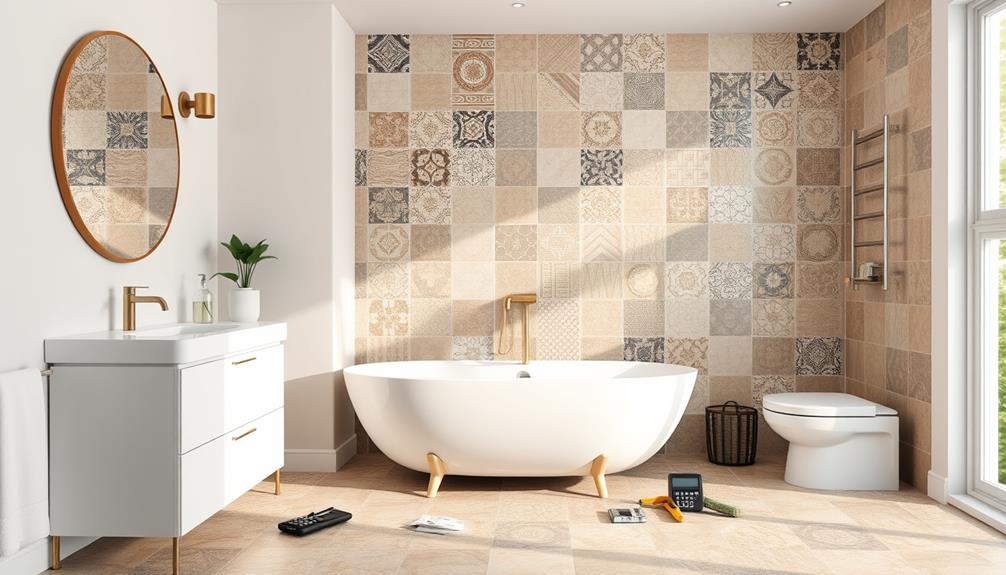
Before you start tiling, make certain to assess the condition of your subfloor; any issues here can complicate the installation and increase costs.
It's also wise to create a personal budget for your remodel to guarantee you stay within your financial means while selecting high-quality materials.
Choosing the right grout is just as important, as it affects both the look and durability of your tile.
Don't forget to budget for installation properly, taking into account the variance in tile costs per square foot and setting aside extra for breakage.
Additionally, understanding the potential budgeting essentials can help you allocate funds effectively throughout the remodeling process.
Assess Subfloor Condition
Evaluating the condition of your subfloor is vital for a successful bathroom tile installation. Start by checking for moisture damage, as this can compromise the structural integrity of your flooring. If you have a wooden subfloor, make certain it's dry and well-supported; moisture can lead to warping or deterioration over time.
Additionally, consider the importance of professional cleaning to maintain a safe and stable environment, as any contaminants can affect your installation.
Next, assess the levelness of your subfloor. Uneven surfaces may require leveling compounds or additional underlayment to create a smooth base for your tiles. Without a level subfloor, your tile installation might suffer from cracks or movement, leading to costly repairs down the line.
If you discover complex issues or extensive damage, consider professional installation. Experts can navigate these challenges effectively, helping avoid mistakes that could escalate your budget.
Grout Selection Importance
Grout selection plays a pivotal role in the success of your bathroom tile project, impacting both aesthetics and maintenance. Choosing the right grout can enhance the beauty of your tiles while also making them easier to clean.
Here are four key considerations for grout selection:
- Grout Colors: Decide between dark grout and lighter grout. Dark grout hides stains and dirt, making it ideal for high-traffic areas. Lighter grout, while beautiful, may require more frequent cleaning.
- Type of Grout: Opt for sanded grout for wider joints as it offers strength and durability. Unsanded grout works well for narrower joints.
- Sealing Grout: Proper sealing of grout is crucial, especially for porous materials. This prevents moisture penetration and staining, reducing the risk of costly repairs.
- Professional Installation: If your grout pattern is complex, consider professional installation. Costs can range from $1 to $3 per square foot, but the investment can guarantee long-lasting tile maintenance.
Budgeting for Installation
When planning your bathroom remodel, budgeting for tile installation is vital to guarantee a smooth process and avoid unexpected costs. Start by calculating the total square footage of your bathroom to determine how many tiles you'll need.
Don't forget to add an extra 10-15% for breakage and cuts during installation. Tile costs can vary widely, ranging from $1 to $15 per square foot, so it's essential to choose materials that fit your budget. Additionally, installation expenses typically range from $4 to $10 per square foot, depending on the complexity of the job.
Consider how investing in quality materials can benefit you long-term, similar to how Gold IRAs offer potential for appreciation and resilience against economic fluctuations.
For intricate patterns or large format tiles, consider professional installation. This can prevent costly mistakes and guarantee a polished finish.
Also, think about long-term maintenance costs. Cheaper tiles might save you money upfront but could require more frequent replacements, impacting your overall budget.
Aesthetic Choices for Bathroom Tiles
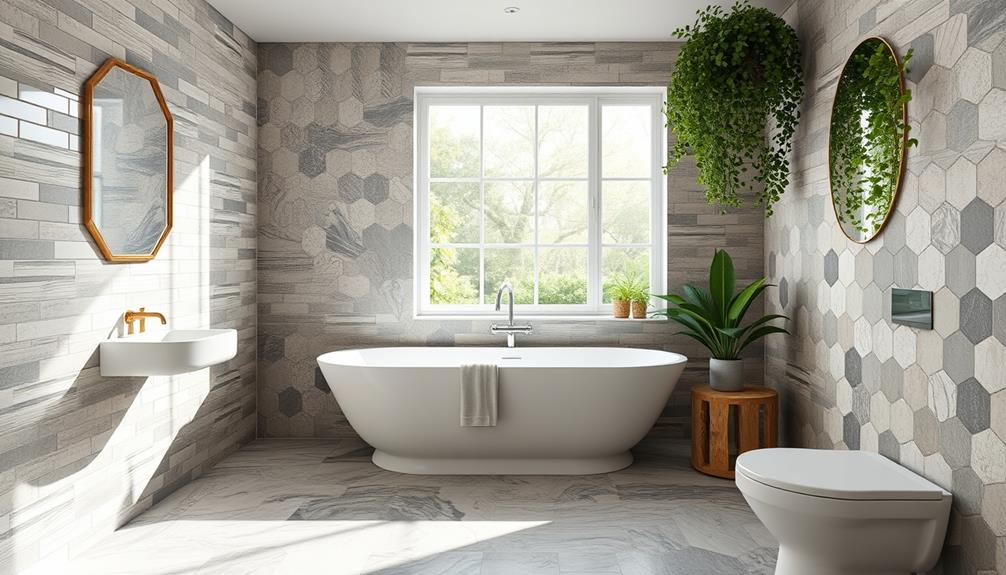
When choosing bathroom tiles, your color palette can set the tone for the entire space, so pick 2-4 cohesive colors.
Additionally, reflect on how the choice of tiles can enhance energy efficiency, as many homeowners are now opting for sustainable materials to align with a minimalist lifestyle, which is a growing trend in the tiny house movement tiny homes and sustainability.
Don't forget to take into account different textures and finishes to add depth and interest.
Color Palette Selection
Choosing a cohesive color palette is essential for a successful bathroom remodel, and limiting your options to 2-4 colors can make a considerable difference. A well-thought-out color palette selection helps create a harmonious, inviting space. Here are some tips to guide your choices:
- Light and Neutral Shades: These colors can create an illusion of a larger bathroom, making it feel airy and spacious. Additionally, using calming colors can help promote a sense of emotional well-being, much like the therapeutic approaches used in effective BPD treatment.
- Darker Colors: Using deeper tones can add warmth and intimacy, especially beneficial in smaller bathrooms.
- Variations of a Single Color: By incorporating different shades of one color, you enhance depth and visual interest throughout the space.
- Nature-inspired Hues: Greens and blues can evoke a calming atmosphere, perfect for a peaceful retreat.
Don't forget to reflect on grout colors, as they greatly influence the overall aesthetic. Lighter grout may show stains more easily, while darker colors can create a sleek, cohesive appearance.
Texture and Finish
A diverse range of textures and finishes can dramatically enhance the aesthetic appeal of your bathroom tiles. When choosing the right texture, consider how it contributes to visual interest and slip resistance. Glossy tiles can reflect light, making your space feel larger, but they often require more maintenance to keep them looking pristine.
In contrast, matte finishes offer a more subdued, natural look and are generally easier to maintain. Additionally, incorporating elements of nature-inspired designs can create a soothing atmosphere, reminiscent of New England's scenic views.
Textured tiles, which feature rough surfaces, are excellent for flooring as they help prevent slips in wet areas while adding depth to your design. You can create a dynamic aesthetic by combining different finish options, such as matte wall tiles paired with glossy accents. This approach allows you to maintain a cohesive color palette while elevating the overall style of your bathroom.
Keep in mind the practical implications of your choices. Textured tiles may trap dirt more easily, while smooth, glazed tiles tend to resist stains and are easier to clean.
Ultimately, balancing aesthetics with functionality will help you select the perfect tiles for your bathroom remodel.
Pattern and Layout
Tile patterns and layouts can greatly transform your bathroom's aesthetic, making it feel more inviting and stylish. By choosing the right design elements, you can create a space that reflects your personality and enhances its functionality. Here are some ideas to contemplate:
- Patterned Tile: Opt for striking patterns, like herringbone or chevron, to add visual interest and depth to your bathroom.
- Tile Sizes: Mix large format floor tiles with smaller accent tiles to create engaging texture and a dynamic look.
- Cohesive Appearance: Use a single type of tile in various layouts—straight, diagonal, or stacked—to maintain a cohesive yet unique appearance.
- Accent Tiles: Strategically place accent tiles or borders to define areas and establish focal points without overwhelming the space.
Don't forget about the grout color! A contrasting grout can accentuate the shapes and lines of your layout, enhancing the overall visual appeal.
Importance of Sampling Tiles
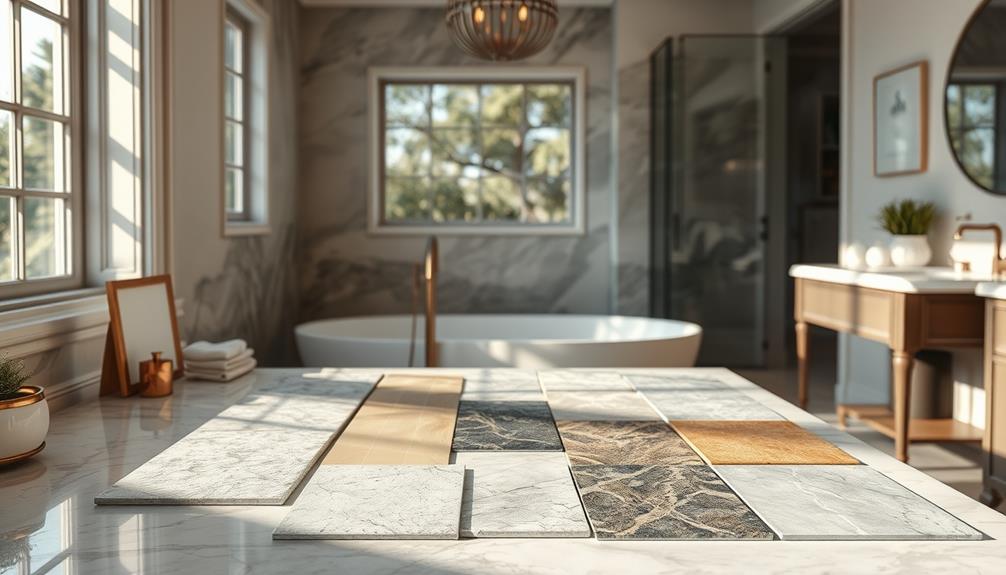
How can you guarantee that your bathroom remodel turns out exactly as you envision? The answer lies in the importance of sampling tiles. By sampling, you can assess the color, texture, and finish under your bathroom’s specific lighting conditions. This step is essential to make sure everything aligns with your design vision. If you are looking for master bathroom remodel ideas, sampling tiles can also help you visualize how different designs and patterns will look in your space. It allows you to experiment with various combinations and make adjustments before committing to a particular style. By taking the time to sample tiles, you can ensure that your master bathroom remodel turns out exactly as you envision.
You can often find free tile samples from retailers, allowing you to visualize how different options will look in your space without spending a dime. Additionally, purchasing smaller samples can help you evaluate how the tiles fit with your existing decor and materials.
To further understand the durability of tiles in high-moisture environments, soak them as part of your testing process. This will help you make informed decisions based on performance. Finally, don't forget to test grout colors with your tile samples, as they can greatly alter the overall aesthetic.
Here's a handy reference for your sampling process:
| Tile Characteristics | Importance |
|---|---|
| Color | Aligns with vision |
| Texture | Affects feel |
| Finish | Complements design |
| Durability | Meets practical needs |
Sampling tiles is your key to a successful remodel!
Measuring and Budgeting for Your Project
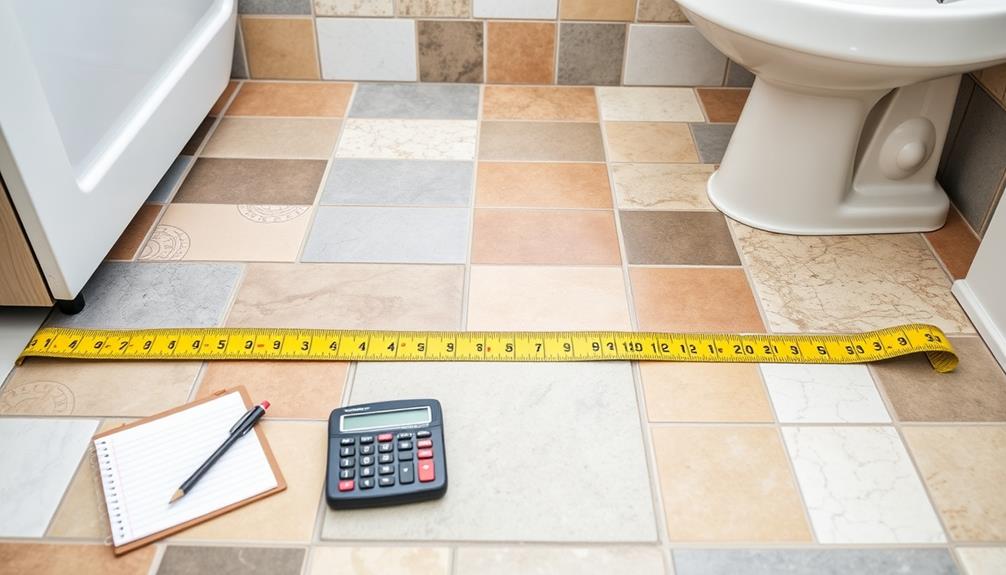
After selecting the perfect tile samples, it's time to focus on measuring and budgeting for your project.
Start by accurately measuring the length and width of your bathroom to calculate the total square footage needed. Don't forget to take into account unique features like alcoves or niches.
Here's a quick guide to help you:
- Measure the Area: Calculate the total square footage by multiplying length by width.
- Add Extra: Increase your total by 10-15% to cover breakage or cutting errors, ensuring you won't run short during installation.
- Set a Budget: Research the cost per square foot of your chosen tile material, like ceramic or natural stone, and factor in additional expenses like grout and adhesive.
- Look for Deals: Keep an eye out for sales, clearance items, and bulk purchasing options to stretch your budget further, potentially allowing you to choose higher-quality tiles.
Frequently Asked Questions
How to Decide on Bathroom Tiles?
To decide on bathroom tiles, consider your space's style and color scheme. Evaluate durability and water resistance, choose the right size, select grout wisely, and test samples in your lighting for the best aesthetic match.
Should Tile Be Lighter or Darker Than Walls?
You've got to weigh your options carefully. If you want spaciousness, go for lighter tiles. For a cozy vibe, darker tiles work wonders. Just guarantee your choice complements the overall mood you're aiming for.
What Is the Best Tile for a Bathroom Remodel?
When considering the best tile for your bathroom remodel, think about durability and maintenance. Ceramic and porcelain tiles offer great options, while vinyl's budget-friendly nature makes it appealing. Natural stone can provide elegance but requires more upkeep.
What Is the 3 4 5 Rule for Laying Tile in a Bathroom?
The 3-4-5 rule helps you guarantee your tile layout has perfect right angles. Measure 3 feet along one wall, 4 feet along another, and check the diagonal distance. It's essential for a professional-looking installation.
Conclusion
In the grand mosaic of your bathroom remodel, choosing the right tile is key to crafting a space that sings with style and function. By considering design, size, and budget, you can transform your bathroom into a personal oasis. Don't forget to sample tiles before committing—like trying on shoes before a big event, it's essential! With thoughtful choices, your bathroom will not only meet your needs but also reflect your unique taste and personality.
